母语在英语学习中的作用
- 格式:doc
- 大小:104.00 KB
- 文档页数:14
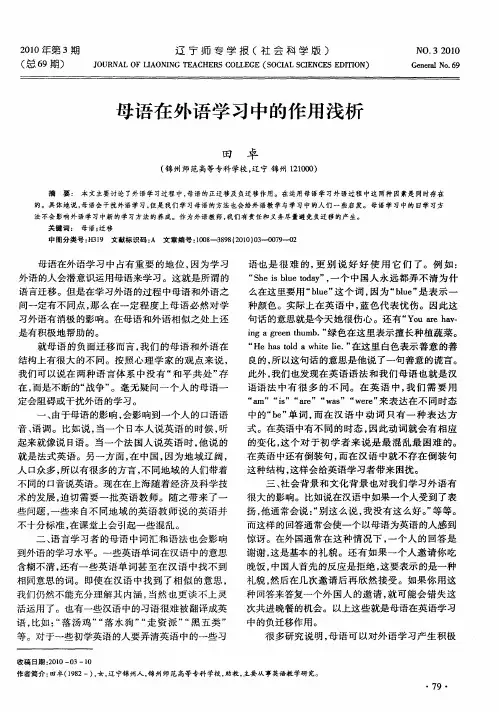
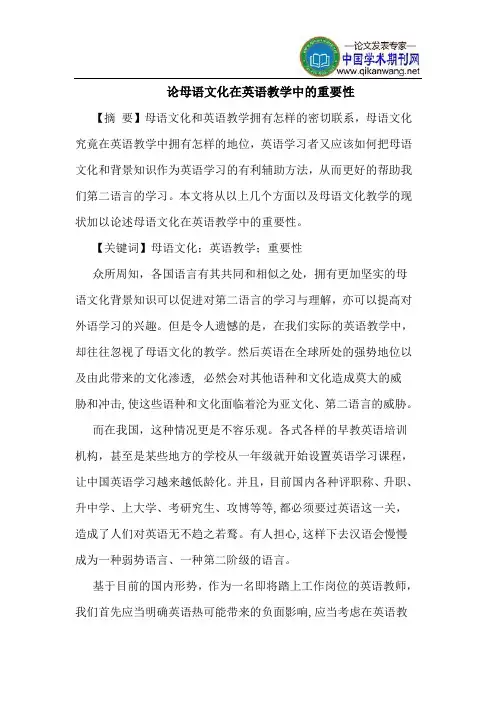
论母语文化在英语教学中的重要性【摘要】母语文化和英语教学拥有怎样的密切联系,母语文化究竟在英语教学中拥有怎样的地位,英语学习者又应该如何把母语文化和背景知识作为英语学习的有利辅助方法,从而更好的帮助我们第二语言的学习。
本文将从以上几个方面以及母语文化教学的现状加以论述母语文化在英语教学中的重要性。
【关键词】母语文化;英语教学;重要性众所周知,各国语言有其共同和相似之处,拥有更加坚实的母语文化背景知识可以促进对第二语言的学习与理解,亦可以提高对外语学习的兴趣。
但是令人遗憾的是,在我们实际的英语教学中,却往往忽视了母语文化的教学。
然后英语在全球所处的强势地位以及由此带来的文化渗透, 必然会对其他语种和文化造成莫大的威胁和冲击,使这些语种和文化面临着沦为亚文化、第二语言的威胁。
而在我国,这种情况更是不容乐观。
各式各样的早教英语培训机构,甚至是某些地方的学校从一年级就开始设置英语学习课程,让中国英语学习越来越低龄化。
并且,目前国内各种评职称、升职、升中学、上大学、考研究生、攻博等等,都必须要过英语这一关,造成了人们对英语无不趋之若鹜。
有人担心,这样下去汉语会慢慢成为一种弱势语言、一种第二阶级的语言。
基于目前的国内形势,作为一名即将踏上工作岗位的英语教师,我们首先应当明确英语热可能带来的负面影响,应当考虑在英语教学中如何维护母语及本族文化的平衡地位。
一、母语是英语学习的基础在英语教学法中应该主张利用母语文化的教学法,以认知教学法为中心,其中应包括传统的语法翻译法,从而主张从学习者现有的背景知识出发,来学习新知识,认为母语是第二语言学习者已经掌握的知识,理应在实际教学中被广泛利用。
只有深入懂得了外国文化才会对母语文化有更深刻的理解,也只有懂得了母语文化才能够更好地掌握外国文化。
主张排斥母语文化的教学法主要是以听说法为中心,包括自然法、视听法、直接法等等。
而主张把第一语言习得的原则来运用到第二语言的学习上,其理论基础是结构主义语言学与行为主义心理学,主要是认为语言即习惯,学习英语即是养成独立于母语的一套全新的语言习惯。

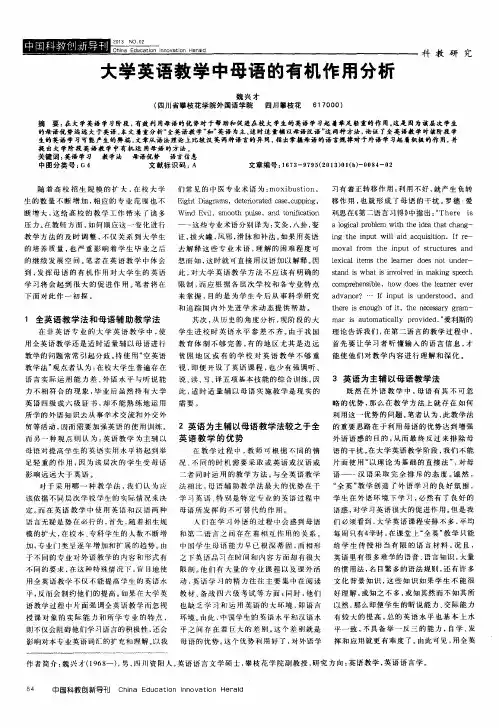
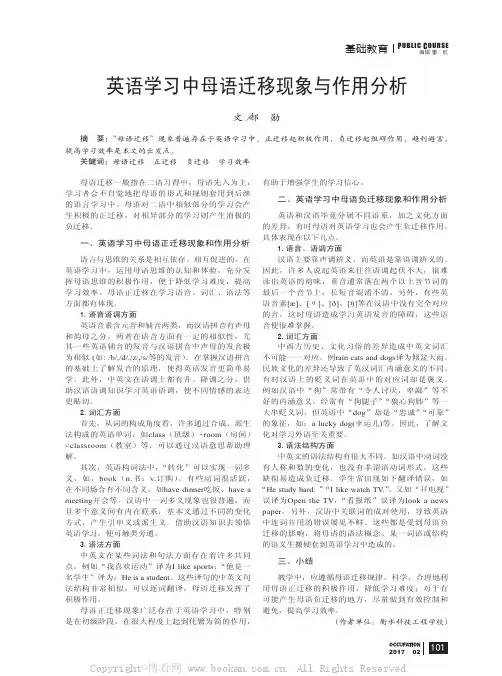
101OCCUPATION2017 02基础教育P UBLIC C OURSE 编辑 董 航英语学习中母语迁移现象与作用分析文/郝 勋摘 要:“母语迁移”现象普遍存在于英语学习中。
正迁移起积极作用,负迁移起阻碍作用,趋利避害,提高学习效率是本文的出发点。
关键词:母语迁移 正迁移 负迁移 学习效率母语迁移一般指在二语习得中,母语先入为主,学习者会不自觉地把母语的形式和规则套用到后继的语言学习中。
母语对二语中相似部分的学习会产生积极的正迁移,对相异部分的学习则产生消极的负迁移。
一、英语学习中母语正迁移现象和作用分析语言与思维的关系是相互依存、相互促进的。
在英语学习中,运用母语思维的认知和体验,充分发挥母语思维的积极作用,便于降低学习难度,提高学习效率。
母语正迁移在学习语音、词汇、语法等方面都有体现。
1.语音语调方面英语音素含元音和辅音两类,而汉语拼音有声母和韵母之分,两者在语音方面有一定的相似性,尤其一些英语辅音的发音与汉语拼音中声母的发音极为相似 (如: /b/,/d/,/z/,/s/等的发音)。
在掌握汉语拼音的基础上了解发音的原理,使得英语发音更简单易学。
此外,中英文在语调上都有升、降调之分。
借助汉语语调知识学习英语语调,使不同情感的表达更贴切。
2.词汇方面首先,从词的构成角度看,许多通过合成、派生法构成的英语单词,如class (班级)+room (房间)=classroom (教室)等,可以通过汉语意思帮助理解。
其次,英语构词法中,“转化”可以实现一词多义,如,book (n.书;v.订购)。
有些动词很活跃,在不同场合有不同含义,如have dinner 吃饭、have a meeting 开会等。
汉语中一词多义现象也很普遍,而且多个意义间有内在联系,基本义通过不同的变化方式,产生引申义或派生义。
借助汉语知识去领悟英语学习,便可触类旁通。
3.语法方面中英文在某些词法和句法方面存在着许多共同点。
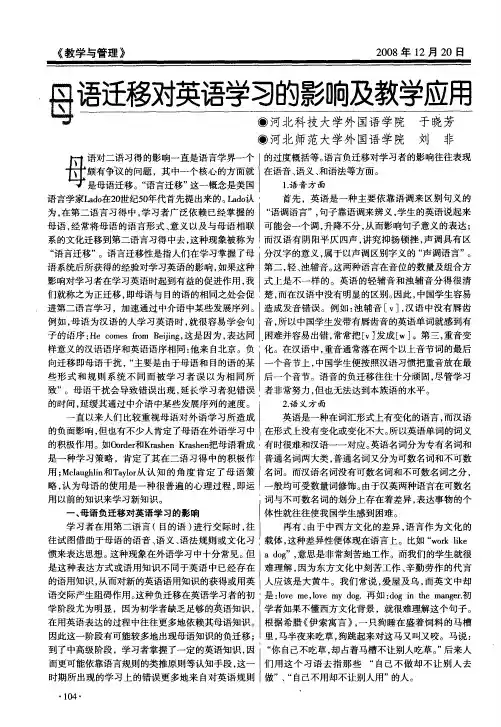
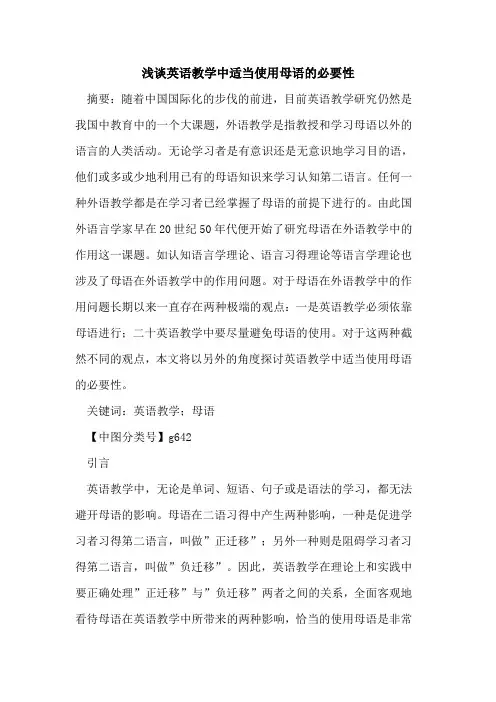
浅谈英语教学中适当使用母语的必要性摘要:随着中国国际化的步伐的前进,目前英语教学研究仍然是我国中教育中的一个大课题,外语教学是指教授和学习母语以外的语言的人类活动。
无论学习者是有意识还是无意识地学习目的语,他们或多或少地利用已有的母语知识来学习认知第二语言。
任何一种外语教学都是在学习者已经掌握了母语的前提下进行的。
由此国外语言学家早在20世纪50年代便开始了研究母语在外语教学中的作用这一课题。
如认知语言学理论、语言习得理论等语言学理论也涉及了母语在外语教学中的作用问题。
对于母语在外语教学中的作用问题长期以来一直存在两种极端的观点:一是英语教学必须依靠母语进行;二十英语教学中要尽量避免母语的使用。
对于这两种截然不同的观点,本文将以另外的角度探讨英语教学中适当使用母语的必要性。
关键词:英语教学;母语【中图分类号】g642引言英语教学中,无论是单词、短语、句子或是语法的学习,都无法避开母语的影响。
母语在二语习得中产生两种影响,一种是促进学习者习得第二语言,叫做”正迁移”;另外一种则是阻碍学习者习得第二语言,叫做”负迁移”。
因此,英语教学在理论上和实践中要正确处理”正迁移”与”负迁移”两者之间的关系,全面客观地看待母语在英语教学中所带来的两种影响,恰当的使用母语是非常重要的。
一母语对英语学习的促进作用在传统的语言学中,大家一致认为母语在外语习得中只能起到阻碍的消极作用,但是近几年的二语习得研究结果指出这样的观点具有片面性,在二语习得中,母语或多或少存在着起积极的促进作用。
著名语言学家schumann(1979)指出在外语习得过程中,母语与外语在结构上的相同或相似性可以加速学习者对某些结构的习得。
ellis(1994)认为母语作为一种已经获得的非常稳定的知识和习惯,当它和目的语类似的时候,母语可以加快目的语的学习过程。
由此可见,母语对学习者习得第二语言的过程中起到了积极的促进作用。
大量的研究表明:在第二语言的认知处理过程中,二语习得者都会有意识或无意识地依靠母语的语言思维习惯对第二语言进行相应的处理。
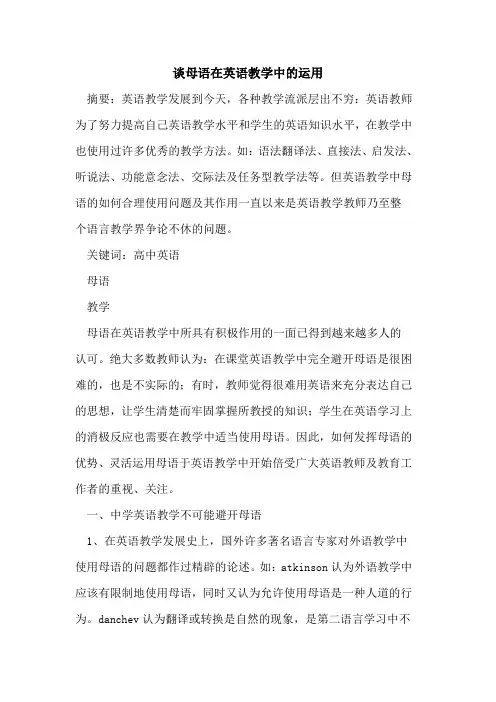
谈母语在英语教学中的运用摘要:英语教学发展到今天,各种教学流派层出不穷:英语教师为了努力提高自己英语教学水平和学生的英语知识水平,在教学中也使用过许多优秀的教学方法。
如:语法翻译法、直接法、启发法、听说法、功能意念法、交际法及任务型教学法等。
但英语教学中母语的如何合理使用问题及其作用一直以来是英语教学教师乃至整个语言教学界争论不休的问题。
关键词:高中英语母语教学母语在英语教学中所具有积极作用的一面已得到越来越多人的认可。
绝大多数教师认为:在课堂英语教学中完全避开母语是很困难的,也是不实际的;有时,教师觉得很难用英语来充分表达自己的思想,让学生清楚而牢固掌握所教授的知识;学生在英语学习上的消极反应也需要在教学中适当使用母语。
因此,如何发挥母语的优势、灵活运用母语于英语教学中开始倍受广大英语教师及教育工作者的重视、关注。
一、中学英语教学不可能避开母语1、在英语教学发展史上,国外许多著名语言专家对外语教学中使用母语的问题都作过精辟的论述。
如:atkinson认为外语教学中应该有限制地使用母语,同时又认为允许使用母语是一种人道的行为。
danchev认为翻译或转换是自然的现象,是第二语言学习中不可避免的,不管老师允许与否,学生不可避免地把外语的结构和词汇与母语相近的东西对等起来。
“外语”(fl)则是指母语之外只在学校里学习而在日常社会生活中缺乏广泛交际用途的语言。
如在中国学习英语,只在课堂里学习,并没有太多的交际、交流需要。
对中国人来说,英语就是外语。
外语靠学来的(study),这里没有语言环境;学习者通过有意识地学习和研究该语言,由于学习者脱离目的语社会环境,他们的学习活动主要是在课堂中进行,他们学习的目的主要是在学会目的语后去阅读外文书籍,了解国外的信息,并能把外语作为交际、求职、加薪等的有利工具。
在这过程中学习者关注的是语言的形式。
由此,我们可以得出:作为“第二语言”的教学和作为“外语”的英语教学就有明显的差别。
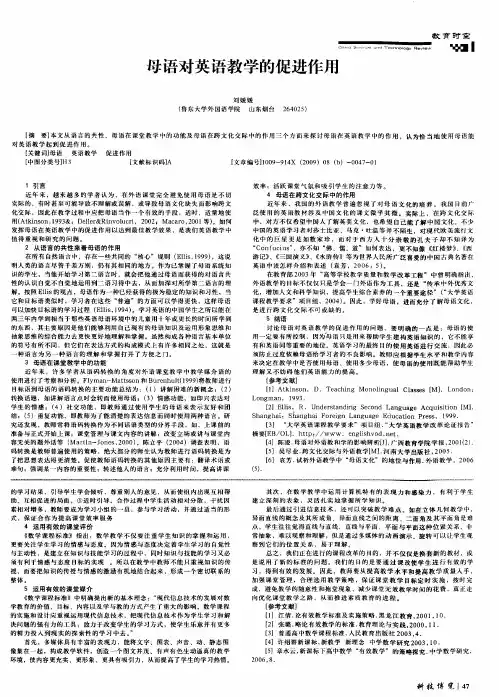

英语课堂中母语的恰当使用近日听了王老师的一节课,感触最深的是课堂上对于母语的恰到好处的使用。
近年来,小学英语教学方法、手段、目标一直在不断革新。
改革的过程逐渐形成了一种评价标准,那就是一堂课的优秀与否很大程度上取决于教师能否达到全英化教学。
反对在外语教学中使用母语的观点,是随着本世纪初直接教学法(Direct Method)的出现而逐步形成的。
直接法强调通过外语本身进行会话、交谈和阅读实施外语教学,明确提出外语教学不应使用学生的母语,不用翻译。
除此之外,情境教学法的广泛使用也使得母语在英语课堂中成为一片禁地,教师认为,只要给学生创设充分的情境,学生就能够理解目标语的含义,使用母语会干扰学生的思维,影响目标语的掌握。
以上观点是不是正确呢?王老师的课上对于母语的使用能给我们一定的启发。
课堂从warming up到review教师采用的都是英语教学,且都为学生可以理解、自如运用的句型。
到presentation部分,需要学生掌握词组“folk music,pop music",教师很自然地运用了母语:《二泉映月》,《高山流水》,folk music;《隐形的翅膀》、《稻香》pop music。
”对于学生而言,稍有一点音乐常识就可以判断出它们分别为“民乐”和“流行乐”。
此处母语使用虽很简短,但起到了画龙点睛的作用。
试想,如果一味地追求全英化教学,对于这两个词组该费多少口舌进行讲解,学生也未必能够明白。
记得以前自己讲课也遇到过类似的问题,课堂上要求学生做游戏,最困难的就是让学生明白游戏规则。
用了很多时间、很多词汇、很多辅助方法,但往往是明白的学生并不多。
为了追求全英教学,丢掉了一种最简捷的方法,那就是利用母语讲解一遍。
原本可能只需要一分钟,结果却用了几倍的时间让学生去理解,而最后的效果却还不如前者。
尤其在提倡高效课堂的今天,既延误了课堂时间,又没有达到预期的效果。
我们所说的“不提倡母语”并不是“拒绝母语”。

母语在英语课堂教学中的使用与功能摘要:母语在外语教学中的使用及其作用一直是二语习得研究者和课堂实践者持久争论的话题。
本文通过对实验数据的定性与定量分析,着重探讨母语在不同类型课堂的应用、其在课堂中应占的合理比重、影响其使用的主客观因素以及教师和学生对其使用的接受程度与期待。
调查结果也表明母语在语言教学中占有不可忽视的地位,尤其在营造课堂氛围、澄清语言重难点、解释抽象概念等方面气着非常重要的作用。
因此,无论作为领导者、教师还是学生,都应该重视母语在外语教学课堂中的扮演的角色与作用,并根据具体学情学况来灵活地、有创造性地调整母语使用策略。
关键词:母语的使用;英语教学;功能1.引言不论在二语习得还是外语教学中,研究者和教师们普遍关注母语在情况复杂的课堂教学中所占的比重及其发挥的作用。
一直占主导地位的传统“直接法(The Direct Method)”、“听说法(The Audio-lingual Method)”严格要求单一语言输入的课堂原则,即提倡在课堂上营造纯英语的学习环境。
而近些年来,在二语习得领域的新浪潮提倡更加实用的“自然法(The Natural Approach)”、“交际法(Communicative Language Teaching)”、“任务型语言教学法(Task-based Language Teaching)”等。
他们认为课堂中合理高效的使用母语,不仅可以降低学生的心理压力、在新知和旧知之间搭建脚手架,而且能够让学生更加清晰本节课的重难点。
但是大多数英语老师由于多年来对母语的误解,导致了所谓的“母语羞耻论”,大家羞于在课堂上使用母语。
因此,如何根据实际情况,有计划、节奏清晰、以目的为导向来探索出一条真正有效的母语使用策略,是当下英语课堂教学亟待解决的问题。
1.文献综述国内外学者对母语在英语课堂教学中的使用都进行了大量的研究。
事实上,我们应该批判性地看待其在不同情况下的作用,合理的使用可以事半功倍,大大提升教和学的效率,但是又不可过度依赖母语,否则也会造成不佳的学习效果。
正确处理和使用母语,提高英语教学效果中国学生生活在中国人说汉语的圈子中,终日被汉语的氛围包围着,他们已经习惯了母语,对于他们来说,英语是第二语言,所以在学习英语的时候,很自然地要受到母语的影响,无论是语音、词汇、和语法等,因此,正确处理母语和英语在学习中的关系成了英语教学的一个关键。
正确恰当地利用母语,科学合理地处理母语与英语的关系,将十分有助于发挥母语在英语教学中的促进作用。
根据有关专家的研究结合本人的教学实践,我认为应该做好一下几个方面。
1.课堂教学以英语为主,恰当适量地使用母语在组织课堂教学的过程中,从开始到结束的各个环节中,凡是能使用英语的地方都要尽可能使用英语。
诸如开始上课时与学生的打招呼、对学生的提问、对学生回答问题的评价、对课本内容的讲解等,这样学生在不知不觉中就学会了很多英语用法。
经常运用英语,学生的听说读写能力就会在教师的这种潜移默化的输入过程中得到提高。
对于教学过程中的某些难点或重点词汇和概念的教学,在使用英语讲解时学生不能或难以理解时,可以恰当地使用母语进行对比解释。
尤其是针对那些意义比较抽象的词汇、复杂的句子和难以理解的语法,用母语解释可以帮助学生理解,同时节省大量的课堂时间,事半功倍,能达到教学的最佳效果。
比如,在让学生理解限制性定语从句和非限制性定语从句的区别时,如果我们用英语去解释可能费时,学生还难以听懂。
我们不妨换种方式,结合英语用汉语来解释。
如对于限制性定语从句,给出学生一个句子She is a woman..她是一位女性,英语中的she就说明了性别,所以此句是废话,但是如果我们对这个词woman加以限定,即加上一个定语从句who loves me very much.就成了一个限制性定语从句She is a woman who loves me very much,这个句子就正确了,学生很快就能理解了。
对于非限制性定语从句,同样给出学生一个句子She is my wife.她是我的妻子,这个句子本来就是对的,不需要添加什么了。
汉语对英语学习的影响随着全球化的发展,英语已经成为世界上最重要的语言之一。
而对于非英语国家的学习者来说,他们的母语对于学习英语也有着重要的影响。
在中国,汉语是学生们的母语,因此汉语对英语学习有着深远的影响。
本文将探讨汉语对英语学习的影响,并从词汇、语法、语音和文化等方面进行分析。
汉语对英语学习的影响体现在词汇方面。
由于汉语和英语属于不同语系的语言,因此两者之间的词汇没有直接的关联性。
在词汇学习的过程中,汉语学习者常常会受到母语的影响,导致他们在英语学习中产生一些误解和错误。
汉语中的一些词汇在英语中并没有直接对应的词,因此学生往往会直译出现问题。
由于中英文化的差异,一些文化内涵丰富的词汇也会难以准确理解和运用。
在英语学习中,学生需要通过大量的阅读和学习,逐渐培养对英语词汇的敏感度和准确理解。
汉语对英语学习的影响还体现在语法方面。
汉语和英语的语法结构有很大的不同,这对汉语学习者在学习英语的过程中造成了一定的困惑。
汉语的语序是主语+谓语+宾语的形式,而英语的语序是主谓宾的形式,这就需要学生在学习英语时适应不同的语言结构。
英语中的时态、语态、情态动词等语法现象在汉语中并没有直接对应,因此也需要学生进行比较和反复训练,才能掌握和运用得当。
这就要求学生在学习英语时要注重对语法知识的细致学习和深入理解,尤其要注重语境和实际运用。
汉语对英语学习的影响还表现在语音和发音方面。
作为汉语母语者,学生在学习英语发音时常常受到母语的影响,导致发音不准确或者有口音。
英语中的元音、辅音和连读等现象在汉语中并没有直接对应,因此学生需要进行大量的反复训练和模仿,才能逐渐掌握英语的发音规律和技巧。
由于发音是语言表达的基础,因此汉语学生在学习英语时,要注重对音标和发音的细致学习和实际训练,才能达到纯正的英语发音水平。
汉语对英语学习的影响还体现在文化方面。
汉语和英语所处的文化环境和社会背景有很大的不同,这就需要学生在学习英语的过程中,逐渐了解和理解英语国家的文化和风俗习惯。
如何用母语辅助语言学习1. 引言在全球化的今天,学习一门外语已经成为许多人的必备技能。
然而,对于非母语者来说,学习一门新的语言并不容易。
幸运的是,我们可以利用自己的母语来辅助语言学习,提高学习效果。
本文将介绍如何用母语辅助语言学习的方法和技巧。
2. 利用母语的词汇和语法知识母语是我们最熟悉的语言,我们可以利用自己已经掌握的词汇和语法知识来辅助学习新的语言。
首先,我们可以通过对比两种语言的词汇和语法结构来加深对新语言的理解。
例如,如果我们学习英语,可以将英语单词与自己的母语单词进行对比,找出它们之间的相似之处和差异之处。
这样做可以帮助我们更快地记忆和理解新的单词。
此外,我们还可以利用母语的语法知识来辅助学习新的语言。
例如,如果我们学习德语,可以将德语的动词变位规则与自己母语的动词变位规则进行对比,找出它们之间的共同点和不同点。
这样做可以帮助我们更好地掌握新语言的语法规则。
3. 利用母语的听力和口语技巧听力和口语是语言学习中最重要的方面之一。
我们可以利用自己的母语来提高听力和口语技巧。
首先,我们可以通过听母语和目标语言之间的对话或录音来训练自己的听力能力。
例如,如果我们学习法语,可以找一些法语和自己母语之间的对话录音,反复听并模仿其中的发音和语调。
此外,我们还可以利用母语来提高口语表达能力。
例如,我们可以找一个母语为目标语言的人进行对话练习,让他们纠正我们的发音和用词错误。
这样做可以帮助我们更好地掌握目标语言的口语表达能力。
4. 利用母语的阅读和写作技巧阅读和写作是语言学习中另外两个重要方面。
我们可以利用自己的母语来提高阅读和写作技巧。
首先,我们可以通过阅读自己母语和目标语言之间的对应文本来提高阅读能力。
例如,如果我们学习西班牙语,可以找一些西班牙语和自己母语之间的对应文章,逐句对照阅读并理解其中的意思。
此外,我们还可以利用母语来提高写作能力。
例如,我们可以先用母语写一篇关于某个话题的文章,然后再将其翻译成目标语言。
母语思维方式对英语学习的影响母语思维方式作为母语文化的心理层面,影响中介语输出,不可避免的产生母语迁移,对学生英语学习具有一定的促进或阻碍作用,因此在外语教学中不能忽视客观存在的母语思维方式的影响,有意识的引导学生自觉进行思维转换。
标签:母语思维方式;母语迁移;英语学习;影响;对策一、引言母语迁移(language transfer)是语言学的热点问题,也是争议颇多的课题。
它是指学习者将母语的某个成分或结构移植到外语学习中。
母语迁移可以发生在语言的各个层面,包括语音,词汇,句法和语篇,有的是对二语学习有促进作用的正迁移,有的是阻碍和不利于二语规范化的负迁移。
不仅母语的语言形式和意义会对中介语(interlanguage)有影响,与母语相关的文化也会迁移到外语学习中,促进或阻碍外语学习的过程。
英语学习不仅仅是一个简单的语言输出过程,它同时也是一个用英语这门外语来展现作者的思维,观点和态度的认知过程。
语言表达从来都不是简单的词汇,语法和句子的组合,更多的体现了包括人的价值观,思维方式,审美情趣,道德情操,宗教感情和民族心理等心理层次的内容。
所以,英语表述中就不可避免的出现了很多体现我们中国人的思维方式的表达和语言结构。
本文试图探讨汉语思维方式对英语学习的影响。
二、母语思维方式和母语文化文化是一个群体的生活方式,它包括人自出生后所学到的一切,如语言,言行方式和内容,信仰以及人们赖以生存的物质和精神基础。
每个民族都有其独特的根深蒂固的文化内涵,尤其表现为一个民族的价值观,思维方式,审美情趣,道德情操,宗教感情和民族心理。
人从出生那一刻就开始接受本族文化的熏陶,可以说,人的所思所想无一不受其本族文化或民族文化的影响,这种根深蒂固的影响是产生文化冲突(culture shock)的根本原因,也是跨文化交际中的最大障碍(戴炜栋,张红玲,2000)。
文化分为物质的和精神的。
而语言表达往往是受精神层面的文化影响的,尤其是思维方式这种心理层面的文化对外语学习的影响是客观存在的。
母语在英语学习中的作用The Role of Mother Tongue in English LearningAbstract: Learner’s L2 acquisition may strongly be influenced by their L1 in the process of foreign language learning. The influence can be also called language transfer.Language transfer can be divided into two aspects-positive transfer and negativetransfer. In respect of this, this paper will briefly discuss the role of L1 in L2acquisition by reviewing some linguists’point of view. Referring to the studyresults of some linguists and researchers, the author will further investigate thepositive transfer and negative transfer, the relationship between L1 and L2. On thebasis of analysis, L1 plays an important role during the process of L2 acquisition.In order to identify the area of language transfer, a procedure called ContrastiveAnalysis was development which will be also explained in this paper.Key words: second language acquisition; mother tongue; language transfer摘要: 在外语学习过程中,学习者通常会把母语知识迁移到外语学习中去,语言的迁移可以分为正迁移和负迁移。
根据一些语言学家者对母语在二语习得中的影响研究,本文讨论了母语在二语习得中的正迁移和负迁移作用及母语和第二语言的关系。
在理论分析的基础上,母语在二语习得的过程中确实扮演着很重要的角色。
为了更好地了解语言的迁移,本文将对错误分析做进一步的分析。
关键词: 二语习得; 母语; 语言迁移ContentsI.Introduction (1)A. Background (1)B. Reasons (1)Ⅱ. Literature Review (2)A.Different views on language transfer (2)B.Behaviorist learning t heory (2)C.Habits (2)D.Errors (3)Ⅲ. An Important Procedure in Language Transfer (5)A.E xplanation of contrastive a nalysis (5)B.The psychological aspect of contrastive a nalysis (5)C.T he linguistic aspect of contrastive a nalysis (6)Ⅳ. The Influence of L1 on L2 learning (7)A.P ositive t ransfer (7)B.Negative t ransfer (8)Ⅴ. The Relationship between L1 and L2 (8)Ⅵ. Conclusion (9)Works Cited (10)Ⅰ. IntroductionA.BackgroundDifferent researchers have given very different interpretations of the definition of second language acquisition. As Cook mentioned “People have been interested in second language acquisition since antiquity, but in modern times much of the research emphasis was in fact placed on language teaching”(Cook 23). Many comparative studies of language teaching methods were conducted. As was mentioned “In the 1960s, as a result of the inconclusive findings from the comparative studies, a debate in psychology over the nature of learning and a revolution in linguistics, a challenge to the dominance of research on language teaching was to take place”(Larsen-Freeman 5). Since Hatch’s book was published in 1978, there have been hundreds more studies conducted, several new journals begun, and numerous conferences convened. Raimes (535) offers an additional indicator of the birth and growth of the SLA field. In recent years, more and more researchers are devoting themselves to second language acquisition.B.ReasonsDuring the process of English learning, there are many factors which can influence our English learning. Among all the factors, L1 plays an important role in L2 learning which is also a hot topic in recent years. Beginning in the post-war years and carrying on into the 1960s, there was a strong assumption that most of the difficulties facing the L2 learner were imposed by his or her first language. It was assumed that where there were differences between the L1 and L2, the learner’s L1 knowledge would interfere with the L2, and where the L1 and L2 were similar, the L1 would actively aid L2 learning. The process that was held responsible for this was called language transfer. In the case of similarities between the L1 and L2 it functioned positively, while in the case of differences it functioned negatively. Teachers were encouraged to focus their teaching on the areas of difficulty created by negative transfer. They were exhorted to apply massive practice to overcome these difficulties. According to this, this paper mainly relies on the role of mother tongue in L2 learning.Ⅱ. Literature ReviewA.Different views on language transferAn important function of human’s language is promoting interpersonal communication. Using language correctly can help promote emotion, developing friendship, respecting each other and improving interpersonal nguage transfer means “the influence of one language on another language” (Longman Dictionary of Language Teaching and Applied linguistics1992). Lear ners’L2 acquisition may strongly be influenced by their L1 in the process of foreign language learning. It is a popular belief that second language acquisition (SLA) is strongly influenced by the learner’s first language (L1) . The clearest support for this belief comes from ‘foreign’ accents in the second language (L2) speech of learners. When a Chinese speaks English, his English sounds Chinese. The learner’s L1 also affects the other language levels-vocabulary and grammar. This is perhaps less immediately evident, but most language learners and teachers would testify to it. It is also a popular belief that the role of the L1 in SLA is a negative one. That is, the L1 gets in the way or interferes with the learning of the L2, such that features of the L1 are transferred into the L2. In fact, the process of SLA is often characterized in popular opinion as that of overcoming the effects of L1, of slowly replacing the features of the L1 that intrude into the L2 with those of the target language and so of approximating ever closer to native-speaker speech. Corder (978) has referred to this view of SLA as a ‘restructuring process’. It is a view that is based on a theory of general learning, as will be explained in the next section.B.Behaviorist learning theoryIn order to understand the early importance that was attached to the role of the first language, it is necessary to understand the main tenets of behaviorist learning theory. Up to the end of the 1960s, views of language learning were derived from a theory of learning in general. There were few studies of SLA based on the actual language that learners produced, and few attempts to examine the process of SLA empirically before this. The dominant school in psychology, which informed most discussions of language learning, was behaviorism. There are two kinds of notions can be identified in these discussions: ‘habits’ and ‘errors’.C. HabitsBehaviorist psychologists attributed two important characteristics to habits. The first was that they were observable. As Watson argued, the true basis for psychological enquiry existed only in objects that could be touched and actions that could be observed. Watson denied the existence of internal mental processes, dismissing them as ‘superstition’and ‘magic’. Thesecond noteworthy characteristic was that habits were automatic, that is, they were performed spontaneously without awareness and were difficult to eradicate unless environmental changes led to the extinction of the stimuli upon which they were built. The learning of a habit, then, could occur through imitation (i.e. the learner copies the stimulus behavior sufficiently often for it to become automatic) or through reinforcement (e.g. the response of the learner is rewarded or punished depending on whether it is appropriate or otherwise, until only appropriate responses are given.Theories of habit formation were theories of learning in general. They could be and were applied to language learning. In L1 acquisition children were said to master their mother tongue by imitating utterances produced by adults and having their efforts at using language either rewarded or corrected. In this way children were supposed to build up knowledge of the patterns or habits that constituted the patterns or habits that constituted the language they were trying to learn. It was also believed that SLA could proceed in a similar way. Imitation and reinforcement were the means by which the learner identified the stimulus-response associations that constituted the habits of the L2. Language learning, first and second, was most successful when the task was broken down into a number of stimulus-response links, which could be systematically practiced and mastered one at a time.D. ErrorsAccording to behaviorist learning theory, old habits get in the way of learning new habits. Where SLA is concerned, therefore, the grammatical apparatus prop rammed into the mind as the first language interferes with the smooth acquisition of the second (Bright and McGregor 236). Behaviorist learning theory predicts that transfer will take place from the first to the second language. Transfer will be negative when there is proactive inhibition. In this case errors will result. Transfer will be positive when the first and second language habits are the same. In this case no errors will occur. Thus differences between the first and second language create learning difficulty which results in errors, while the similarities between the first and second language facilitate rapid and easy learning. In behaviorist accounts of SLA, errors were considered undesirable. They were evidence of non-learning, of the failure to overcome proactive inhibition. Some language teaching theorists even suggests that there was a danger of errors becoming habits in their own right if they were tolerated. However, as errors were the result of the negative transfer of first language habits (i.e. were habits already); it is difficult to see how they could become habits simply by tolerating them. Errors, according to behaviorist theory, were the result of non-learning, rather than wrong learning. But in eithercase there was almost total agreement that errors should be avoided. To this end attempts were made to predict when they would occur. By comparing the learner’s native language with the target language, differences could be identified and used to predict areas of potential error. In this way classroom practice could be directed on the problem areas in order to help the learner overcome the negative effects of first language transfer.Abbott puts it, ‘The aim of any EA is to provide a psychological explanation’ (124). The following list can show us a clear explanation of EA.The distinction between ‘errors’ and ‘mistakes’, which has already been discussed with regard to the identification stage of EA, is also relevant in explaining deviations-demonstrating the interdependence of these two steps in EA. Any deviation from target-language norms may reflect either a problem in performance or in competence. It is helpful to recognize two different kinds of performance mistakes. These mistakes result from such strategies as circumlocution and paraphrase which a learner uses to overcome the lack of knowledge. The latter are known as communication strategies. As we have already seen, it is competence errors that have been considered central to the study of L2 acquisition.Ⅲ. An Important Procedure in the StudiesA.Explanation of contrastive analysisContrastive Analysis was rooted in the practical need to teach a L2 in the most efficient way possible. Lado (416), one of the prime movers of Contrastive Analysis, makes clear that ‘The teacher who has made a comparison of the foreign language with the native language of the students will know better what the real problem are and can provide for teaching them’. The origins of Contrastive Analysis, therefore, were pedagogic. This was reflected in comparisons of several pairs of languages by scholars in the United States, all directed at establishing the areas of learning difficulty that were likely to be experienced by English speakers learning other languages. In addition to these pedagogically oriented studies, there have been a number of more theoretical contrastive studies carried out in Europe, some of which have not been concerned with SLA at all. Clearly Contrastive Analysis is an area of considerable theoretical interest for general linguistics. Contrastive Analysis had both a psychological aspect and a linguistic aspect. The psychological aspect was based on behaviorist learning theory, and the linguistic aspect, in the first place at least, on structuralism linguistics.B.The psychological aspect of contrastive analysisThe psychological ration takes the form of the Contrastive Analysis Hypothesis. This exists in a strong and a weak form. The strong form claims that all L2 errors can be predicted by identifying the differences between the target language and the learner’s first language. As Lee (180) notes, it stipulates that ‘the prime cause, or even the sole cause, of difficulty and error in foreign language learning is interference coming from the learner’s native language’. The strong form of the hypothesis was common before research began to show that many of the errors produced by L2 learners could not be traced to the L1.The weak form of the hypothesis claims only to be diagnostic. A Contrastive Analysis can be used to identify which errors are the results of interference. Thus, according to the weak hypothesis, Contrastive Analysis needs to work hand in hand with an Error Analysis. First actual errors must be identified by analyzing a corpus of learner language. Then a Contrastive Analysis can be used to establish which errors in the corpus can be put down to differences between the first and second language. Implicit in the weak version is the assumption that not all errors are the result of interference. The weak form claims a less powerful role for the L1 than the strong form of the hypothesis.The strong form of the hypothesis has few supporters today. It is now evident that the L1 is not the sole and probably not even in the prime cause of grammatical errors. Nevertheless,the weak form is not very satisfying. It makes little sense to undertake a lengthy comparison of two languages simply to confirm that errors suspected of being interference errors are indeed so. As James (280) points out, this is a ‘pseudo procedure’. In order to hypothesize that the errors in a corpus are interference errors, a de facto contrastive analysis must have taken place. It makes little sense to conduct a complicated contrastive analysis simply to confirm what a de facto analysis suggested.Ideally the psychological aspect of Contrastive Analysis should deal with the conditions under which interference takes place. That is, it should account for instances when linguistic differences between the first and second language lead to transfer errors and instance when they do not. It is because it is not possible to predict or explain the presence or absence of transfer errors solely in terms of linguistic differences between the first and second languages that a psychological explanation is necessary.C.The linguistic aspect of contrastive analysisMost contrastive analyses have compared phonological systems, probably as recognition of the role that the L1 plays in ‘foreign’ accents. However, the Contrastive Structure Series provided full-length studies of the contrastive syntax of the major European languages and English, while the 1970s saw a number of studies in European (see James 1980: 205 for a list). As Sridhar (681) notes, there have been relatively few studies of vocabulary, while Lado’s (428) suggestion that contrastive studies of cultures should be carried out has not been taken up.There are several problems concerning the linguistic aspect of Contrastive Analysis. However, if the problems with Contrastive Analysis were only linguistics, they would be amenable to a linguistic solution. As the tools of contrastive linguistics grow more refined, the problems would be gradually resolved. The major problems, however, have to do with the relationship between the psychological and the linguistic aspects of Contrastive Analysis. There is little point in comparing languages if learners make only limited use of their first languages in SLA. The accuracy of prediction will always be open to doubt if Contrastive Analysis fails to specify the conditions that determine if and when interference takes place. The ‘hierarchy of difficulty’ was an attempt to solve this problem linguistically, but unless the solution has psychological validity (e.g. corresponds to what learners actually do), it will be inadequate. Contrastive Analysis constituted a hypothesis, and like all hypotheses was open to empirical investigation. The real failure of the 1960s was to rely on extrapolation from a general learning theory instead of getting down to the business of testing out theory byexamining the language that learners produce.Ⅳ. The Influence of L1 on L2 learningThe results of the influence of L1 on L2 learning can be divided into two aspects—positive transfer and negative transfer.A.Positive transferMost Chinese learners learn English through instructions that they get in English class. We seldom speak or use English out of class. In English learning, our mother tongue has many negative influences on English learning while it can also have many positive influences. It was said that “all languages in the world have some common features such as the same classification of words and sentences (e.g. all words can be divided into noun, verb, adjective and so on), different expressions about the same time and same places (e.g. we can say ‘7点’in Chinese while we say seven o’clock in English )” (Yang 122). On this condition, we may put these common principles into our second language learning unconsciously which can make great contribution to our second language learning. For Chinese learners of English, it can do us a favor in our English learning if we have learnt Bopomofo; English grammar learning can stand on Chinese grammar learning; Skills of reading and writing Chinese can also be used in English reading and writing, so existent knowledge and skills are helpful to the second language acquisition.Corder (956) outlines one way in which “interference’can be recast as a learner ‘strategy’. He suggests that the learner’s L1 may facilitate the developmental process of learning a L2, by helping him to progress more rapidly along the ‘universal’ route when the L1 is similar to the L2. ‘Interference’errors result not from negative transfer but from ‘borrowing’. That is, when learners experience difficulty in communicating an idea because they lack the necessary target language resources, they will resort to their L1 to make up the insufficiency. This explains why the L1 is relied on more at the beginning of the learning process than later-the learner has greater insufficiency of target language resources to surmount. Whereas interference has been traditionally seen as a feature of learning, intercession is to be considered as a strategy of communication. A rather similar proposal is made by Krashen (981), when hr suggests that learners can use the L1 to initiate utterances when they do not have sufficient acquired knowledge of the target language for this purpose.Both Corder’s and Krashen’s proposals view the L1 as a resource which learners can use to overcome their limitations.B. Negative transferFor learners of English in China, English is learnt as a second language. So in the process of English learning, many teachers and learners think that there is more negative transfer than positive transfer in English learning because of the differences in language and culture between Chinese and English. As a result, “many researchers are holding an opinion that learners should learn English as their mother language and speak in English instead of speaking Chinese frequently”(Krashen 573). As the researchers said, there must be negative influence of L1 on SLA which can be represented in many different aspects. Learner s’L2 acquisition may strongly be influenced by their L1 in the process of foreign language learning; as a result, features of their native language are probably transferred into the target language and cause the effect of negative transfer. For example, in English writing, because of the different culture background, Chinese and foreigners have the different thoughts in writing structure, so Chinese learners may write an English article in Chinese way. Also, there are some different ways of people’s thinking except grammar and words writing. In China, people pay more attention to the connection of the whole article while foreigners focus on direction and brevity. Chinese learners who don’t know the difference will be controlled by their mother language and write a “Chinglish” article. What’s more, learning environment can also play an important role in negative transfer in English learning.Ⅴ.The Relationship between L1 and L2As is shown in part Ⅲ, we should have a brief comprehension on the relationship between L1 and L2. Firstly, second language learning can not exist without L1. We are born with L1 learning and later L2 learning, so L2 learning can be operated on the base of L1. We can regard L1 as the knowledge springhead, we rely on it to complete the input process of foreign language knowledge unconsciously. In fact, it is very common that L1 can influence L2 learning, because while learning a second language, we just learn the linguistry and other knowledge is connected with it instead of apperceiving the world again. Because language learning and language acquisition are two different processes, they can not be divorced from each other in second language learning. In a world, L1 plays an important role in L2 learningand L2 learning should be operated on the base of L1.Ⅵ. ConclusionAlthough in popular belief SLA is strongly influenced by the learner’s L1, there is considerable disagreement among researchers about the extent and nature of role of the L1. The explanation for this lies mainly in the changes that have taken place in the psychological base for examining SLA. The role of L1 was first seen in terms of transfer theory and was closely linked to behaviorism, which saw SLA as a process of habit-formation. Errors, according to this theory, were the result of interference from the entrenched habits of the L1. Contrastive Analysis was developed in order to predict the areas of difficulty that learners with specific L1s would experience, so that teaching could provide massive practice to eliminate the chance of errors induced by the first language. Up to this point, however, there were few empirical studies of SLA. Contrastive Analysis was based on an extrapolation from general learning theory. The beginnings of the 1970s saw a number of attempts to validate the Contrastive Analysis Hypothesis. These showed that many of the errors predicted by Contrastive Analysis did not in fact arise. Also many errors which were not predicted did occur. As a result of this research, the importance of L1 interference was questioned and fell into disfavor. Theoretical attacks on the validity of behaviorist accounts of language learning also helped to create a ‘crisis’ in Contrastive Analysis. Gradually, however, the role of the L1 was reappraised rather than rejected out of hand. The reappraisal took two forms. The Contrastive Analysis Hypothesis was modified to take account of avoidance, the need for there to be a ‘degree of similarity’between the first and second language items for interference to take place, and the multi-factor nature of learner error. Also the Contrastive Analysis Hypothesis was incorporated into a cognitive framework by reinterpreting ‘interference’ as ‘intercession’, a strategy for communicating when there were insufficient L2 resources. More recently, interest in Contrastive Analysis has shifted to reflect current developments in linguistics which emphasize the communicative uses of language. This development is known as ‘Contrastive Pragmatics’.The learner’s L1 is an important determinant of SLA. It is not the only determinant, however, and may not be the most important. But it is theoretically unsound to attempt a precise specification of its contribution or even to try to compare its contribution with that of other factors. The L1 is a resource of knowledge which learners will use both consciously andsubconsciously to help them sift the L2 data in the input and to perform as best they can in the L2. Precisely when and how this resource is put to use depends on a whole host of factors to do with the formal and pragmatic features of the native and target language (e.g. linguistic factors) on the one hand, and the learner’s stage of development and type of language use (e.g. psycho and sociolinguistic factors) on the other hand. The influence of the L1 is likely to be most evident in L2 phonology-the ‘foreign’ accent is ubiquitous-but it will occur in all aspects of the L2. Perhaps the most unsatisfactory aspect of traditional Contrastive Analysis was the assumption that this influence was a negative one. If SLA is viewed as a developmental process, then the L1 can be viewed as a contributing factor to this development, which in the course of time, as the learner’s proficiency grows, will become less powerful.Works CitedAbbott, G. International Review of Applied Linguistics. Oxford: Oxford University Press, 1980.Bright, J. And G. McGregor. Teaching English as a Second Language: Theory and Techniques for the Secondary Stage. Foreign Language Teaching and Research Press, 1970.Cook, Vivian. Linguistics and Second Language Acquisition. Beijing: Foreign Language Teaching and Research Press, 2000.Corder, S. P. Language-learner language. Oxford: Oxford University Press, 1978.Crystal, D. The Statistics of English Today. Beijing: Foreign Language Teaching and Research Press, 1985.Eckman, F. Markedness and The Contrastive Analysis Hypothesis. Oxford: Oxford University Press, 1977.Ellis, Rod. The Study of Second Language Acquisition. Oxford: Oxford University Press, 1994.Gass, S. The Revolution of Conflicts Among Competing Systems. Beijing: Foreign Language Teaching and Research Press, 1987.Jackson, H. Contrastive Analysis As A Predictor of Errors, with Reference to Learners of English. Shanghai: Foreign Language Teaching and Research Press, 1981.James, C. Conreastive Analysis. Oxford: Oxford University Press, 1980.Krashen, S. Language Transfer in Language Learning. Beijing: Foreign Language Teaching and Research Press, 1983.Lado, R. Liguistics Across Culture. Michigan: University of Michigan Press, 1957.Larsen-Freeman, Diane. An Introduction to Second Language Acquisition Research. Beijing: Foreign Language Teaching and Research Press, 2000.Lee, W. Contrastive Linguistics and its Pedagogical Implications. Washington, D. C.: Georgetown University Press, 1968.Raimes, A. Tradition and Revolution in ESL Teaching. Beijing: Foreign Language Teaching and Research Press, 1983.Sridhar, S. Constrastive Analysis, Errors Analysis and Interlanguage. Oxford: Oxford University Press, 1981.Schachter, J. A New Account of Language Transfer. Oxford: Oxford University Press, 1983. Wode, H. The L1 VS. L2 Acquisition of English negation. Oxford: Oxford University Press, 1978.杨连瑞. 二语习得研究与中国外语教学[M]. 上海:上海外语教育出版社, 2007.。